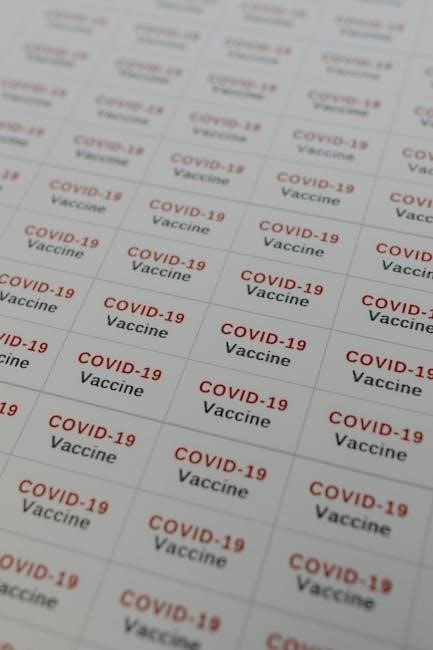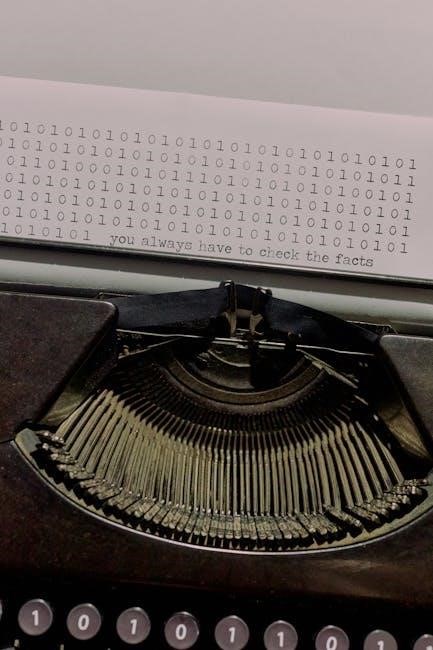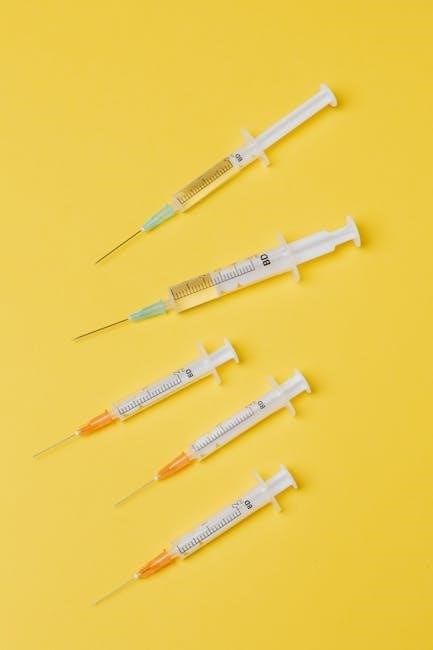A medical coding cheat sheet is a quick-reference guide containing essential codes, guidelines, and terminology. It streamlines the coding process, saving time and reducing errors. Printable PDF versions offer a convenient, portable tool for healthcare professionals to stay organized and efficient.
What is a Medical Coding Cheat Sheet?
A medical coding cheat sheet is a concise, quick-reference guide containing essential codes, guidelines, and terminology for medical coders. It typically includes ICD-10, CPT, and HCPCS codes, along with coding rules and conventions. Designed for portability and ease of use, these resources streamline the coding process, reducing errors and saving time. Available as printable PDFs, they offer a customizable and accessible tool for healthcare professionals to stay organized and efficient in their daily tasks.
The Importance of a Medical Coding Cheat Sheet in Healthcare
A medical coding cheat sheet is vital for ensuring accuracy and efficiency in healthcare billing and documentation. It simplifies complex coding systems, reducing errors and enhancing compliance with industry standards. By providing quick access to essential codes and guidelines, it streamlines the coding process, allowing healthcare professionals to focus on patient care. Cheat sheets also serve as valuable training tools, helping new coders master ICD-10, CPT, and HCPCS codes while maintaining consistency across healthcare settings;

Key Components of a Medical Coding Cheat Sheet
A medical coding cheat sheet includes ICD-10, CPT, and HCPCS codes, along with guidelines, modifiers, and examples for accurate billing and efficient coding processes.
Overview of ICD-10 Codes
ICD-10 codes are alphanumeric codes classifying diseases, symptoms, and medical conditions. They are part of the International Classification of Diseases, 10th Revision, used globally for billing and health data. These codes are highly specific, incorporating details like laterality and severity. A free printable medical coding cheat sheet PDF often includes common ICD-10 codes, helping coders quickly identify and assign the correct codes for diagnoses, ensuring accurate claims and compliance with healthcare standards. Regular updates keep them relevant, boosting efficiency and accuracy in medical billing processes.
Understanding CPT Codes
CPT (Current Procedural Terminology) codes are standardized codes used to report medical, surgical, and diagnostic procedures and services. Maintained by the American Medical Association (AMA), these codes help healthcare providers bill accurately for services; A free printable medical coding cheat sheet PDF often includes CPT codes, enabling quick reference for coders. They are essential for streamlined billing, ensuring proper reimbursement and compliance with healthcare regulations. Regular updates keep coders informed about changes in procedural coding, enhancing efficiency and accuracy in medical billing processes.
Role of HCPCS Codes
HCPCS (Healthcare Common Procedure Coding System) codes are used to report non-physician services, medical equipment, and supplies. Unlike CPT codes, HCPCS codes cover items like durable medical equipment, orthotics, and prosthetics. They are alphanumeric and categorized into two levels: Level I (CPT codes) and Level II (codes for non-physician services). HCPCS codes are essential for accurate billing of non-physician services and equipment, ensuring compliance with healthcare regulations. Regular updates ensure the codes remain relevant and effective for coding professionals.

Benefits of Using a Medical Coding Cheat Sheet
A medical coding cheat sheet streamlines the coding process, reduces errors, and enhances productivity. It saves time, ensures accuracy, and helps maintain compliance with industry standards.
Streamlining the Coding Process
A medical coding cheat sheet simplifies the coding process by providing quick access to essential codes, guidelines, and terminology. It reduces the need to search through extensive manuals, saving time and minimizing delays. Organized by specialty or frequency, the cheat sheet ensures coders can quickly locate relevant codes, streamlining their workflow.
This efficiency reduces errors and boosts productivity, allowing coders to focus on accurate and compliant billing. The structured format ensures easy navigation, making it an indispensable tool for healthcare professionals.
Reducing Errors in Medical Billing
A medical coding cheat sheet serves as a quick-reference guide, reducing billing errors by providing essential codes, guidelines, and examples. It ensures accurate code selection and application, minimizing mistakes in claims submission. By highlighting key rules, such as laterality and modifier usage, it helps coders avoid common pitfalls. Regular updates keep the information current, ensuring compliance with the latest regulations and further reducing the likelihood of errors in medical billing processes.
Enhancing Productivity for Coders
Medical coding cheat sheets enhance productivity by providing quick access to essential codes, guidelines, and examples. They streamline the coding process, reducing time spent searching for information. Printable PDF formats allow coders to work efficiently, even offline, while customization options enable tailoring to specific needs. Regular updates ensure coders stay current with the latest codes and guidelines, minimizing delays and improving workflow efficiency. This centralized resource empowers coders to focus on complex tasks, boosting overall productivity and accuracy in medical billing and documentation.

Organizing Codes for Efficiency
Organizing codes by specialty, frequency, or anatomical system enhances accessibility and reduces search time. Categorizing codes into sections like diagnostics or procedures streamlines workflow and minimizes errors.
How to Organize Codes by Specialty
Organizing codes by specialty involves categorizing them into focused lists for specific medical fields, such as cardiology or pediatrics. This approach ensures quick access to relevant codes, streamlining the coding process. Use tabs, color-coding, or sections to differentiate between specialties. Include common ICD-10 and CPT codes for each area, along with notes or guidelines for complex cases. Regular updates ensure the cheat sheet remains relevant, reducing search time and minimizing errors. This method is particularly useful for coders working in specialized healthcare settings.
Prioritizing Frequently Used Codes
Prioritizing frequently used codes enhances efficiency by placing the most common ICD-10 and CPT codes at the forefront. This reduces time spent searching for less frequently used codes and minimizes errors. Organize the cheat sheet by specialty or practice focus, ensuring quick access to essential codes. Regular updates keep the content relevant, reflecting changes in coding regulations and user needs. Customization allows coders to tailor the sheet to their workflow, making it a practical and indispensable tool for daily tasks.

Customizing Your Cheat Sheet
Customizing your cheat sheet allows you to tailor it to your specific needs, improving efficiency and reducing errors. Add notes, highlight key sections, or focus on specialty-specific codes. Many downloadable PDFs are editable, enabling you to organize and prioritize information according to your workflow. This adaptability makes the cheat sheet a personalized tool, enhancing learning and efficiency. Customization ensures the content remains relevant, catering to individual preferences and professional requirements, while reducing clutter and improving productivity.

Coding Guidelines and Conventions
Coding guidelines ensure accuracy and compliance, with key rules for ICD-10 and CPT, such as laterality and modifier usage. Official sources like AMA and CMS provide credibility, while examples help apply rules correctly in complex scenarios.
Highlighting Key Coding Rules
Medical coding cheat sheets emphasize essential rules for accurate coding, such as ICD-10 laterality and specificity requirements. CPT codes require proper modifier usage and sequencing. Official guidelines from AMA and CMS ensure compliance, while examples help apply rules in complex scenarios. Regular updates reflect coding changes, keeping coders informed. Highlighting these rules reduces errors and improves efficiency, ensuring accurate billing and adherence to industry standards. This focus on key coding conventions makes cheat sheets indispensable for maintaining precision and consistency in medical coding tasks.
Official Guidelines for ICD-10 and CPT
Official guidelines for ICD-10 and CPT provide standardized rules for accurate coding. ICD-10 guidelines, maintained by CMS, ensure proper diagnosis coding, while CPT guidelines, updated by AMA, govern procedural coding. These resources include instructions on laterality, sequencing, and modifier usage. Regular updates reflect regulatory changes, ensuring compliance. Cheat sheets often incorporate these guidelines, offering examples and tips for complex scenarios. Adhering to these official guidelines ensures accurate billing, reduces errors, and maintains compliance with healthcare standards, making them indispensable for coders.
Regular Updates for Compliance
Regular updates are crucial for maintaining compliance with evolving medical coding regulations. Coding guidelines, such as ICD-10 and CPT, are updated annually to reflect new codes, revisions, and deletions. Printable PDF cheat sheets are often updated to include these changes, ensuring coders have the most accurate information. Staying informed about updates helps prevent errors, ensures proper reimbursement, and maintains adherence to industry standards. This continuous improvement makes cheat sheets an essential tool for ongoing accuracy and efficiency in medical coding practices.

Convenience of Printable PDF Formats
Printable PDF formats offer easy access, portability, and cost savings. They can be downloaded, printed, and shared, providing a convenient tool for coders to stay organized and efficient.
Accessibility and Portability
Printable PDF formats ensure easy access and portability, allowing coders to carry essential information anywhere. These sheets can be downloaded, printed, and used offline, saving time and reducing errors. Their compact size eliminates bulky manuals, making them ideal for clinics, remote work, or field settings. Easy sharing among teams fosters collaboration and consistency, while the ability to print and customize enhances versatility. This portability simplifies the coding process, enabling professionals to focus on accurate and efficient patient care.
Cost Savings and Easy Sharing
Free printable medical coding cheat sheets offer significant cost savings, eliminating the need for expensive resources. They are easily shareable among teams, fostering collaboration and consistency. PDF formats allow seamless distribution, reducing printing costs and ensuring accessibility. These budget-friendly tools are ideal for students and professionals, providing essential coding information without financial strain. Regular updates further enhance their value, ensuring they remain relevant and accurate for continuous learning and professional growth.
Customization Options for Specific Needs
Medical coding cheat sheets in PDF format often include customization options, allowing users to tailor them to their specific needs. Coders can edit, add notes, or highlight important sections, making the sheets more personalized. Many downloadable PDFs enable organization by specialty, workflow, or priority, reducing clutter and enhancing productivity. This adaptability is particularly useful for specialized fields, ensuring quick access to relevant codes. Regular updates and editable features keep the resource aligned with individual or practice-specific requirements, making it a versatile tool for efficient coding.

Trusted Sources for Medical Coding Resources
Professional organizations like AHIMA and AAPC provide reliable medical coding resources, including cheat sheets. Websites such as Cheatography and Formsbank also offer customizable templates for coders.
Professional Organizations Like AHIMA and AAPC
Professional organizations like AHIMA (American Health Information Management Association) and AAPC (American Academy of Professional Coders) are trusted sources for medical coding resources. They provide accurate and updated materials, including free printable medical coding cheat sheets in PDF format; These resources include ICD-10, CPT, and HCPCS code guides, along with coding guidelines and tips for complex scenarios. Regular updates ensure compliance with the latest regulations, making them invaluable for continuous learning and professional growth in the field of medical coding.
Reputable Websites for Downloadable Cheat Sheets
Reputable websites like Formsbank and Cheatography offer free, downloadable medical coding cheat sheets in PDF format; These platforms provide customizable templates and forms, allowing users to tailor resources to their specific needs. They include essential codes, such as ICD-10, CPT, and HCPCS, along with guidelines for accurate billing. Regular updates ensure compliance with the latest coding changes, making them invaluable for healthcare professionals seeking reliable, efficient, and accessible tools to enhance their coding skills and stay informed.
Ensuring Accuracy and Compliance
Reputable cheat sheets incorporate official guidelines from sources like the AMA and CMS, ensuring accurate billing and compliance. Regular updates reflect coding changes, keeping users informed. Highlighting key rules, such as laterality and modifier usage, and including examples for complex scenarios, enhances accuracy. Cross-referencing with official resources boosts trustworthiness, making these tools indispensable for maintaining compliance with industry standards and ensuring precise medical coding practices across healthcare settings.

Common Types of Medical Coding Cheat Sheets
Specialty-specific cheat sheets, mental health guides, and anesthesia/surgical references are common types. These tools cater to diverse needs, ensuring quick access to relevant codes and guidelines.
Specialty-Specific Cheat Sheets
Specialty-specific cheat sheets are tailored to niche medical fields like cardiology, pediatrics, or orthopedics. They provide focused code lists, ensuring quick access to relevant diagnoses and procedures.
These tools are designed to meet the unique demands of each specialty, offering a concise reference for coders. Printable PDF formats allow easy customization, making them indispensable for efficient and accurate coding in specialized care settings.
Mental Health and Specialty Coding Guides
Mental health and specialty coding guides provide focused resources for niche fields like psychology and behavioral health. These guides include specific ICD-10 and CPT codes relevant to mental health diagnoses and treatments.
They help coders accurately bill for services such as therapy sessions, assessments, and medications. Printable PDF formats ensure accessibility, while customization options allow users to tailor guides to their specific needs, enhancing efficiency and compliance in mental health coding.
Anesthesia and Surgical Coding References
Anesthesia and surgical coding references provide specialized guides for procedures requiring precise coding. These resources include CPT codes for surgical services, anesthesia time-based coding, and modifiers. They ensure accurate billing for complex procedures, adhering to specific guidelines. Printable PDF formats allow easy access, while customization options help coders focus on relevant codes. Regular updates maintain compliance with changing regulations, ensuring efficiency and accuracy in anesthesia and surgical coding processes.

Customization and Adaptability
Customization allows coders to edit, personalize, and organize their cheat sheets, ensuring they meet specific needs and enhance efficiency in medical coding tasks.
Editing and Personalizing Your Cheat Sheet
Editing and personalizing your cheat sheet allows coders to tailor it to their specific needs. Many downloadable PDFs are editable, enabling users to add notes, highlight key sections, or organize codes by relevance. This customization enhances efficiency, as coders can prioritize frequently used codes or focus on specialty-specific terminology. Regular updates and adaptability ensure the cheat sheet remains relevant, making it an indispensable tool for continuous learning and professional growth in medical coding.
Focus on Specialty-Specific Codes
Focusing on specialty-specific codes enhances efficiency for coders in niche fields like cardiology, pediatrics, or orthopedics. These codes are tailored to meet specific demands, offering a concise reference for diagnoses and procedures. Printable PDF formats allow easy customization, ensuring quick access to relevant codes. This approach reduces clutter and improves productivity, making the cheat sheet an indispensable tool for accurate and efficient coding in specialized healthcare settings.
Enhancing Learning and Efficiency
Medical coding cheat sheets enhance learning by providing a clear, structured approach to understanding complex coding systems. They serve as a valuable training tool, helping both students and professionals master ICD-10, CPT, and HCPCS codes. By offering a centralized resource for quick reference, these sheets reduce search time and minimize errors. Regular updates ensure continuous learning and adaptation to industry changes, while customization options allow tailoring to specific needs, fostering efficiency and professional growth in the field of medical coding.
Medical coding cheat sheets are indispensable tools, simplifying the coding process and ensuring accuracy. They support continuous learning and professional growth, essential for healthcare professionals.
The Indispensable Role of Cheat Sheets in Medical Coding
Medical coding cheat sheets are essential tools for streamlining the coding process. They simplify complex coding systems like ICD-10 and CPT, offering quick access to critical information. By providing pre-organized codes and guidelines, cheat sheets enhance accuracy, reduce errors, and save time. They serve as invaluable references for both new and experienced coders, ensuring compliance with industry standards. Their portability and customization options make them indispensable for training and everyday use, directly supporting professional growth and efficient coding practices.
Continuous Learning and Professional Growth
Medical coding cheat sheets foster continuous learning and professional development by providing concise, organized resources. They help coders stay updated on coding changes and industry standards, ensuring accurate billing and compliance. Regular updates and customizable options allow coders to adapt to evolving requirements, enhancing their skills and efficiency. These tools are especially valuable for students and professionals seeking to expand their knowledge and maintain proficiency in the ever-changing field of medical coding.





